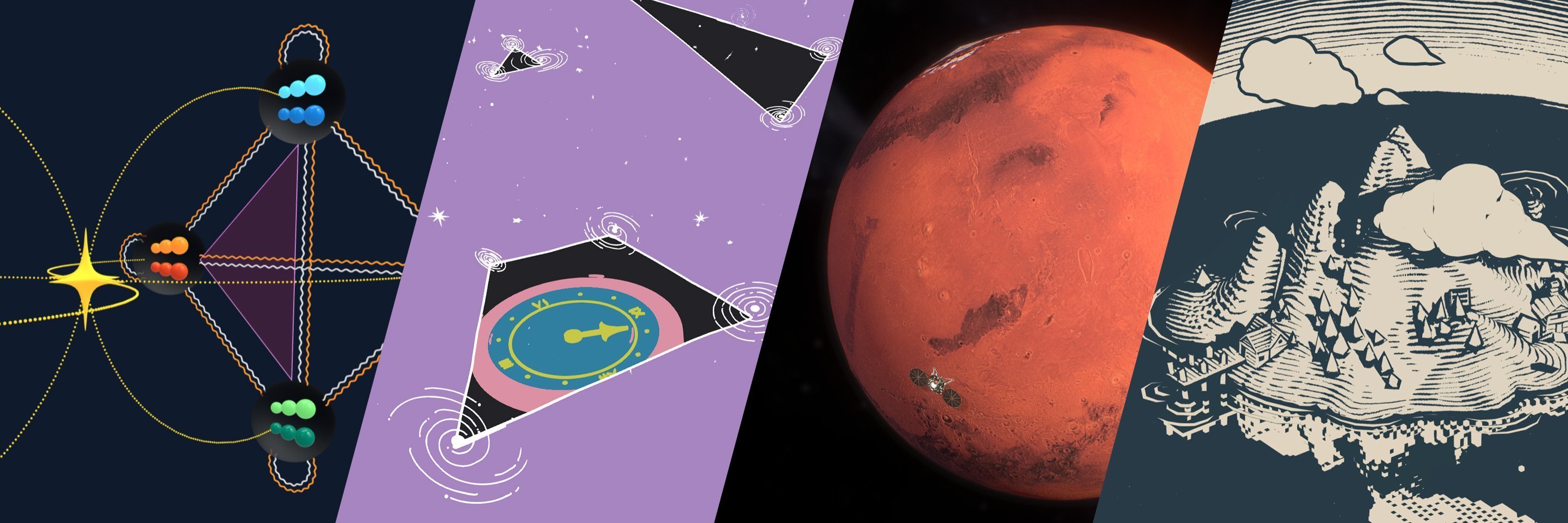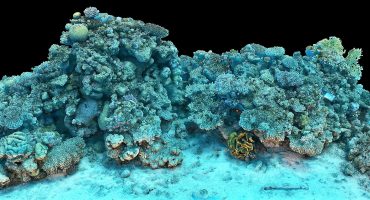Introduction
Hello! My name is Olena Shmahalo and I’m an interdisciplinary artist. My formal education was split between art, design, and science, but until a couple of years ago it didn’t include any digital 3D (unless you count house-building in The Sims). I got into it mostly for work.
Since 2014, I’ve been Quanta Magazine’s art director. Quanta is a free online publication that has been covering advancements in the fundamental sciences and mathematics since 2012. Despite its relative youth, Quanta has quickly become something of a cult favorite among researchers and science enthusiasts alike.
Visualizing science for storytelling
Browsing scientific illustration on any platform, you’ll find a lot of tangible things such as biological specimens or space scenes. But much of the research Quanta covers is theoretical and/or entirely invisible: quantum processes, higher-dimensional geometries, and time, just to name a few. And our goal is not necessarily to make realistic representations (impossible in some cases) but to tell a story and spark interest. If a visual can communicate the essence of a concept well enough that someone can internalize and own it, all the better.
To facilitate making those visuals, I started learning 3D using Cinema 4D. It’s a powerhouse of features for design and animation—perfect for a generalist. The intuitive interface made it easy to learn and start creating (this was before the major UI overhaul that made Blender the de facto newbie-friendly starting software). I soon discovered that 3D is a lot of fun and have been using it for all kinds of projects, including as a base for 2D artworks:
 Credit: Olena Shmahalo/Quanta Magazine
Credit: Olena Shmahalo/Quanta MagazineWhy Sketchfab?
During my “3D journey” I found Sketchfab via ArtStation, and it opened up a whole new realm of possibilities. Sketchfab’s strength lies in tapping into the desire for immersive interaction—the same felt when we like a sketch better than a finished painting (the former invites us to partake actively by filling in the blanks). Or all the mindless rotating and panning that any 3D artist is familiar with. And personally, I enjoy sandbox-style and open-world video games—I often use console cheats just to explore the carefully crafted environments. Sketchfab scratches that same itch: it strips away all the AI trying to kill you and leaves the exploration. I find myself on this site playing around with others’ creations for longer than I care to admit.
This all figures into the ways I use Sketchfab to make visuals for Quanta. (Though I’ll note the obligatory “opinions expressed are solely my own and may not express those of my employer.”) I like to experiment with Sketchfab’s capabilities, and sometimes publish those to my personal account.
Inspecting & experimenting
Here’s a recent example: in math and science, we often deal with various manifestations of change over time. In Cinema 4D that’s easy to animate using tools like splines (curves that can be used as a track along which something can move or grow) or fields (similar to those in physics, “a spatial distribution of strength values that control an effect“). But Sketchfab-readable animations can only scale, move, or rotate. Or they have to be alembics (kind of like a flip-book, if each page was a file—these can get heavy). So, I wanted to try making something unravel using only basic scale transformations. Scaling it up in one go won’t look like unraveling; it must be done in parts. Stitched together, they appear to be one fluid piece:
It’s nothing fancy, but figuring out how to do something simply with the tools available is part of the fun of 3D. And the combined effect is synergistic: a picture becomes an experience.
My favorite Sketchfab tool is probably the Model Inspector. I’ve always liked physicist Richard Feynman’s oft-quoted “ode to a flower”—the idea that taking something apart to see how it works ignites our interest rather than spoiling the magic. Using the Inspector, I love discovering all the clever methods other artists employ to create illusions and stretch the limitations of these tools. Like Feynman, seeing how they did it only makes me more interested.
Sparking curiosity through interaction-driven discovery
This “cosmic clocks” illustration was inspired by such probing:
The story is about researchers gaining insights about time by studying geometric arrangements of galaxies. I’d seen the diorama technique on Sketchfab (for example, used in this mushroom plate) and thought it’d be perfect for this. The technique itself felt like an echo of the story: revealing something through hidden geometry. And though it’s a little risky (because we can’t ensure interaction or payoff), I like the idea of giving a viewer the opportunity to make a discovery for themselves.
In another example of employing illusion to illustrate science, we hired Thomas Shahan, known for his woodcut-like pieces, to create an artwork for a geophysics article. It’s about the discovery that our world may be made of cubes, so the conceit here was to reveal this cubic nature via the reflection in the water.
The lack of lighting and flat textures make Thomas’s models look like 2D images at first. Even if you’re navigating Sketchfab and you know what you’re going to get, there remains a feeling of surprise. It’s like walking into a painting. It’s only a small marvel, but I like that it mimics the feelings of awe that accompany scientific discoveries like this one. Completely unsurprising: this is one of our most popular uploads to date.
Choosing the right medium
But not every model has to do all that work. Sometimes it’s just about using the best medium for the job. If we’re talking about a 3D object, why not show it in 3D? And Sketchfab embeds are so light (a lossless interactive model can be smaller than a compressed video, or even the same size as a high-res JPG) and work well across devices—there’s no drawback to these engaging “educational toys.”
The ability to add annotations (with links and even images) is crucial for making these models useful for readers; they’re one of the reasons I chose Sketchfab over similar viewers. We took full advantage of annotations in this 3D realization of our Standard Model of Particle Physics (explained in full in the related article, A New Map of All the Particles and Forces):
And again for this recent Mars model, showing where InSight landed and the sites relevant to the volcanic activity discussed in the related story, Rumbles on Mars Raise Hopes of Underground Magma Flows:
And beyond
The latter examples are more in line with how models are usually used: as a kind of “sample” or “mock-up,” simplified and abstracted from its context. But 3D models needn’t be stuck in those narrow constraints. Across math, science, and art, we all use the same trick: looking past what something is to see what it can be. It’s inspiring to see the creative ideas people come up with when conventions are dismantled and boundaries are crossed. And I see a vast world of opportunity here, especially to use this alongside or in place of more widely accepted narrative mediums. Going forward, I’d love to collaborate more with other 3D artists to realize wonderful, unconventional ideas, or just make cool models.
If you found this illuminating you can follow Quanta Magazine:
- Facebook: @QuantaNews
- Twitter: @QuantaMagazine
- Instagram: @QuantaMag
- Weekly newsletter
And find me as @NatureInTheory:



